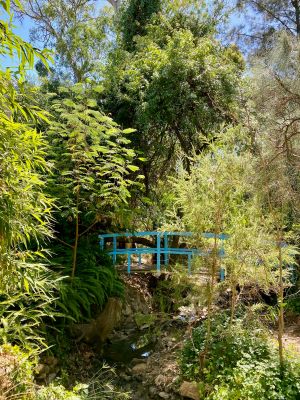Our new bridge built over Second Creek, with the dense wonga vine growing above and beyond into the gum trees, photo Susan Marsden, 2024
In her article in Australian Garden History, vol. 32, no.3, January 2021, Susan Marsden drew on diary entries to record how she and her partner adapted their Adelaide garden in the face of the climate crisis. Here is Susan Marsden’s update on how they are coping.
In the 2020s, climate change continued to affect planting and our garden in general, sometimes in contradictory ways. We situated most new plants in semi-shade, regardless of ‘full sun’ label instructions. The rare rainforest tree, the Wollemi pine (Wollemia nobilis), went into a pot with a dripper (as placed in all of the garden pots except succulents). We propagated from seeds and cuttings sun-tolerant plants, both indigenous and introduced – such as the cheerfully long-flowered salvias – and inserted succulents as border edging along paths, where the sprinklers may not reach. I continued to document the changing garden in photos and in diary notes. I learnt to annotate the photos on my mobile phone, and to add plant names suggested from websites. I noted which plants cope well during high summer, such as our mass-plantings of native grasses. In line with garden tradition, we swapped useful seedlings, cuttings and herbs with friends and family, including clivias and Zygocactus from my mother’s garden, now sold. Our herbs also flourished, perhaps because most derive from similarly arid climates.
There’s much to be learnt from researching the origins of our garden plants in determining which may survive and even thrive in rising heat.
Climate data confirmed 2023 as the world’s hottest year.[1] In Australia, the increase in temperature combined with an El Niño event caused a cascade of storms, heat and fires. These extreme weather events pose their own challenges. Adelaide experienced a milder and wetter summer than usual. Our own climate change adaptation included having to deal with the flooding of Second Creek. In late spring in 2023 a violent flood undermined part of our creekside garden and wrecked the old timber bridge. We’d anticipated that, and had commissioned Matt Dunk to build a stronger bridge, supported on steel beams. The blue-painted bridge, combining practicality with beauty, was finished in time for all the family to enjoy by Christmas.
In 2023, anticipating a hotter and dryer spring, we had turned on the automatic watering system in early September, sooner than usual. As a result of the warmth and extra water vigorous climbers such as the Australian native wonga vine (Pandorea pandorana) and bower of beauty (Pandorea jasminoides), and the lovely but feral morning glory (Ipomoea indica) exploded into wild and scrambling growth. If I was to give one word of advice about planting morning glory, it would be: don’t. We had to engage a gardening team to hack into and remove this rampant growth. The work date was to be in March 2024, although this risked removing shade from vulnerable garden plants as well as exposing tender new growth to a burning sun. In line with the shifting pattern of seasons with climate change, a run of over-35 degree days was forecast, and an extreme weather alert was issued for 10 March. This was too dangerous for garden work, quite apart from the risk to plants. The gardener said that severe summer weather in autumn is here to stay, and we agreed to shift the big work day of heavy pruning to late April. This is another lesson to be learnt by gardeners in a time of global warming.
[1] Copernicus Climate Change Service reported by ABC News 10 January 2024, viewed February 2024, https://www.abc.net.au/news/2024-01-10/2023-earths-hottest-year-on-record/103258396.
This article is one of a series prepared for a project, Antipodean historic gardens and climate change, partly funded by a grant from the international charity, the Historic Gardens Foundation.


